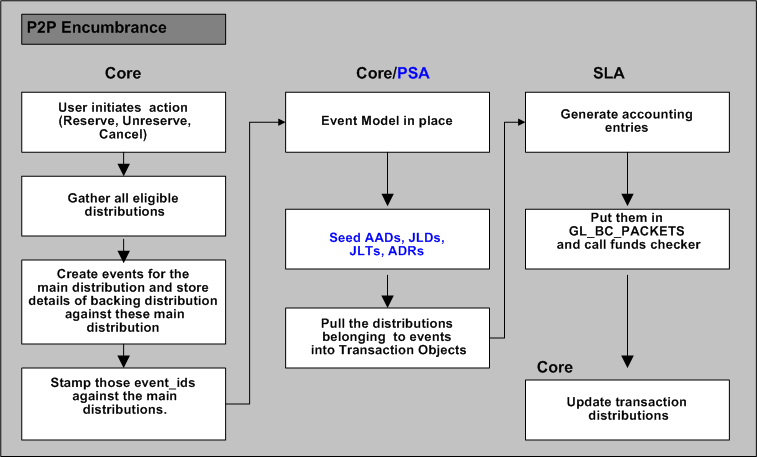Encumbrance Accounting Using Oracle Subledger Accounting
Overview
Subledger Accounting is an intermediate step between each subledger applications and Oracle General Ledger. Subledger Accounting creates the final accounting for subledger actual and encumbrance journal entries and transfers the accounting data to General Ledger. It stores a complete and balanced subledger journal entry in a common data model for each business event that requires accounting.
Subledger Accounting provides a uniform approach to accounting and a common set of tools that enable you to configure and customize accounting rules for applications that require accounting. It includes a common user interface and a set of programs that can generate accounting for Oracle and non-Oracle applications. When you set up rules in Subledger Accounting, you can define the types of lines, descriptions, and accounts to store on journal entries. Subledger Accounting partitions data by subledger application, while storing the information in a common model. The subledger accounting method chosen at the Ledger determines what type of accounting is created, for example, Standard Accrual or Encumbrance Accrual.
If the budgetary control is enabled, or an encumbrance Subledger Account method is chosen, the subledger captures the budgetary control events at the same time that the budgetary control is called. For example, a budgetary control event is created when funds are requested to be reserved for a purchase order. In some cases, this will result in the capture of two accounting events at the same time. For example, when an invoice is approved, there could be both an ‘Invoice Approved’ and a ‘Budgetary Control Invoice Approved’ accounting event.
First the encumbrance accounting is created, then the transactions are checked against the funds available. The encumbrance accounting feature is separated from the budgetary control feature and is created by the Subledger Accounting engine.
Public Sector Financials predefines Subledger Accounting setup for Encumbrance Accounting so that the create accounting process accepts the default accounting information from subledgers without change. You can optionally define your own detailed encumbrance accounting rules to enable Subledger Accounting to create encumbrance accounting entries.
Accounting Event Model Overview
Accounting events represent transactions that have a financial accounting impact. Public Sector Financials generates accounting events for the business events that it processes. The Create Accounting process creates subledger accounting entries for the accounting events. The Transfer Journal Entries to General Ledger process transfers the accounting entries to General Ledger.
Event represents the business event in the life-cycle of a document. For example, a business event takes place when you create a Purchase Order in Oracle Purchasing. The Account Generator workflow then automatically creates accounting entries for the purchase order. Next, you choose to check funds or reserve funds, then the budgetary control creates budgetary control event, calls the Subledger Accounting Create Accounting process that creates encumbrance accounting entries for these accounting events in Oracle Subledger Accounting, then the funds are checked or reserved.
Each Event Entity is associated with one or more Event Classes. An Event Class represents a category of business events for a particular transaction type or document. The Example of the Event Classes in procure-to-pay process are Requisition, Purchase Order, Credit Memo, or Prepayment. Event entities in procure-to-pay process are Requisition, Purchase Order, Receipt, Invoice, and Payment. Event classes group similar Event types and enable sharing of accounting definitions.
An Event type represents a business operation that you can perform for an Event class. An example of the Event Type is ‘Requisition Created’ or ‘Requisition Reserved’. An accounting event has both an Event class and an Event type that impacts how a Create Accounting process determines the subledger accounting for it.
Oracle Public Sector Financials provides a predefined set of Event classes and Event types for each encumbrance accounting Event entity.
The accounting definitions are used to create journal entries. A Subledger Accounting Create Accounting process creates all accounting entries for all subledgers. Users can use the standard report submission features to submit the Create Accounting process at regular intervals to automatically process encumbrance accounting events. Detailed subledger accounting journals are available for analytics, auditing, and reporting and can be summarized, transferred, imported, and posted to Oracle General Ledger.
Procure to Pay Encumbrance Accounting Process Overview
The following diagram explains Procure to Pay Encumbrance Process based on Requisition example.

In Purchasing:
-
A user enters a requisition and reserves or unreserves funds, or cancels the requisition.
-
Distributions are created and all eligible distributions are gathered.
-
The events for the main distributions are created and the backing distribution details are stored against the main distribution details.
-
The Event IDs of the events created in the previous step are stamped against the main distributions in Oracle Public Sector Financials.
In Public Sector Financials:
-
Assuming event model is in place, seed Application Accounting Definitions, Journal Line Definitions, Journal Line Types and Account Derivation Rules are selected.
In Purchasing:
-
The distributions belonging to the events are pulled into Transaction Objects.
In Subledger Accounting:
-
Accounting entries are generated.
-
Stored in GL_BC_PACKETS table, and the funds checker is called.
In Purchasing:
-
The transaction distributions are updated.
Related Topics
Oracle Subledger Accounting Implementation Guide